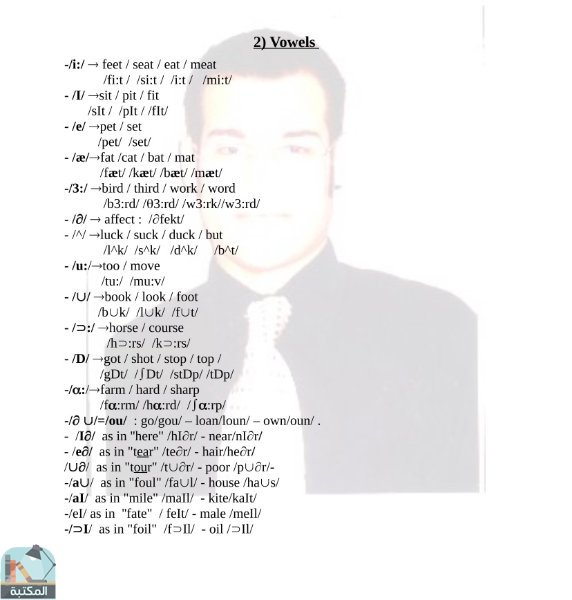📘 ❞ علم صوتيات اللغة الأنجليزية واتجاهات معاصرة في علم اللغة ❝ كتاب ــ رضا السعيد اصدار 2004
كتب تعلم اللغة الإنجليزية - 📖 كتاب ❞ علم صوتيات اللغة الأنجليزية واتجاهات معاصرة في علم اللغة ❝ ــ رضا السعيد 📖
█ _ رضا السعيد 2004 حصريا كتاب ❞ علم صوتيات اللغة الأنجليزية واتجاهات معاصرة ❝ 2025 اللغة:
كتاب يعلم كيفية النطق الصحيح من خلال الرموز الصوتية مزودة بأمثلة وقواعد أخري هامة للنطق الأستاذ Preface A large number of students face great difficulty in understanding, and appreciating Phonetics Linguistics The fault is usually not theirs, but rather that their teachers who the same difficult to understand, once we grasp quintessential characteristics its sounds Once achieve that, will find it easy appreciate a linguistic work In part which discusses English sounds, I tried give representative carefully chosen examples They are well known liked enjoyed, hope you enjoy them too, they instill love as The First Part: Phonetics Phonetics general study Speech Organs (1)The Vocal Cords: They bands elastic tissues larynx When vocal cords spread apart, air from lungs passes between unimpeded causing voiceless sound drawn together, repeatedly pushes apart through, creating vibration voiced (2)The Larynx: It structure at top wind pipe lungs, contains (3)The Pharynx: immediately above space behind tongue reaching up towards nasal cavity (4)The Tongue: most important organs speech has greatest variety movement It divided into four parts: (1)Tip (2)Blade (3)Front (4)Back (5)The lips: take various different positions, for example: can be brought firmly together p or b so completely block mouth (6)The Teeth: The lower front teeth upper ones (7)The Palate: roof mouth, soft palate back, hard middle, alveolar ridge, just (8)The Alveolar ridge: gums very consonant like b,d,t,n,r,s,z,j,3,d3 made with touching close ridge 9) Aspiration: short period after explosion p,t,k when leaves without voice 10) Consonant: one set seriously obstructed occurs similar positions words 11) Friction Consonants: by narrowing passage until interfered causes friction 12) Gliding consonants no stop have rapid glide vowel 13) Diphthong: smooth position another, whole acting long , simple vowels 14) Phonemic Transcription: representation each phoneme single symbol 15) Received Pronunciation: kind pronunciation used many educated speakers, particularly south east England Sometimes called B C 16) Stress: greater effort on syllable syllables word longer utterance than other 17) Bilabial: two lips come m 18) Labiodentals: lip f v 19) Dental: tip blade comes contact 20) Alveolar: The touches directly d t n l s z r 21) Palato alveolar: while concave 22) Palatal: approximates plate j 23) Velar: back k,g,n,w كتب تعلم الإنجليزية مجاناً PDF اونلاين وتعليم الانجليزية للمبتدئين والمتقدمين والاطفال والكبار والطلاب والجرامر والقواعد النحوية وقواميس للترجمة
- مساهمة من: رضاالسعيد عبد الباسط أحمد
( الأحد 11 مايو 2008 ( 1:05 مساءً )) - تبليغ عن سوء استخدام

كتاب يعلم كيفية النطق الصحيح من خلال الرموز الصوتية مزودة بأمثلة وقواعد أخري هامة للنطق.
الأستاذ/ رضا السعيد
Preface
A large number of students face great difficulty in understanding, and appreciating Phonetics and Linguistics. The fault is usually not theirs, but rather that of their teachers who face the same difficulty.
Phonetics is not difficult to understand, once we grasp the quintessential characteristics of its sounds. Once we achieve that, we will find it easy to understand, and appreciate a linguistic work.
In the part which discusses the characteristics of English sounds, I tried to give representative and carefully chosen examples. They are well-known examples which I liked and enjoyed, I hope that you will enjoy them too, and that they will instill in you a love of Phonetics as well as Linguistics.
The First Part: Phonetics
Phonetics is the general study of the characteristics of English sounds.
Speech Organs
(1)The Vocal Cords:
They are bands of elastic tissues in the larynx.
When the vocal cords are spread apart, the air from the lungs passes between them unimpeded causing a voiceless sound.
When the vocal cords are drawn together, the air from the lungs repeatedly pushes them apart as it passes through, creating a vibration causing a voiced sound.
(2)The Larynx:
It is a structure at the top of the wind-pipe from the lungs, which contains the vocal cords.
(3)The Pharynx:
It is immediately above the larynx and it is a space behind the tongue reaching up towards the nasal cavity.
(4)The Tongue:
It is the most important part of the organs of speech as it has the greatest variety of movement. It is divided into four parts: (1)Tip. (2)Blade. (3)Front. (4)Back.
(5)The lips:
They take up various different positions, for example: they can be brought firmly together as in /p/ or /b/ so that they completely block the mouth.
(6)The Teeth:
The lower front teeth and the upper front ones are important in speech.
(7)The Palate:
It is the roof of the mouth, divided into the soft palate at the back, the hard palate in the middle, and the alveolar ridge, just behind the teeth.
(8)The Alveolar ridge:
It is the part of the gums immediately behind the upper front teeth. It is very important as most of the consonant sounds like /b,d,t,n,r,s,z,j,3,d3/ are made with the tongue touching or close to the alveolar ridge.
9) Aspiration:
It is a short period after the explosion of /p,t,k/ when air leaves the mouth without voice.
10) Consonant:
It is one of a set of sounds in which air from the lungs is seriously obstructed in the mouth, and which occurs in similar positions in words.
11) Friction Consonants:
They are sounds made by narrowing of the air passage until the air is interfered with and causes friction.
12) Gliding Consonants:
They are consonants with no stop or friction which have a rapid glide to a vowel.
13) Diphthong:
It is a smooth glide from one vowel position to another, the whole glide acting like one of the long , simple vowels.
14) Phonemic Transcription:
It is the representation of each phoneme by a single symbol.
15) Received Pronunciation:
It is the kind of pronunciation which is used by many educated speakers, particularly in south-east England. Sometimes it is called B.B.C. English.
16) Stress:
It is a greater effort on a syllable or syllables in a word or longer utterance than on the other syllables.
17) Bilabial:
The two lips come together as in /b/p/m/.
18) Labiodentals:
The lower lip and the upper teeth come together as in /f/v/.
19) Dental:
The tip or the blade of the tongue comes in contact with the upper teeth as in //
20) Alveolar:
The tip or the blade of the tongue touches the alveolar ridge which is directly behind the upper teeth as in /d/t/n/l/s/z/r/.
21) Palato-alveolar:
The tip of the tongue is close to the alveolar ridge while the front of the tongue is concave to the roof of the mouth .
22) Palatal:
The front of the tongue approximates to the hard plate as in /j/.
23) Velar:
The back of the tongue approximates to the soft palate as in /k,g,n,w/.
#791
0 مشاهدة هذا اليوم#5K
14 مشاهدة هذا الشهر#753
138K إجمالي المشاهدات- 🎁 كن أول كاتب اقتباس في هذه الصفحة واحصل على هديّة 15 من النقاط فوراً 🎁





